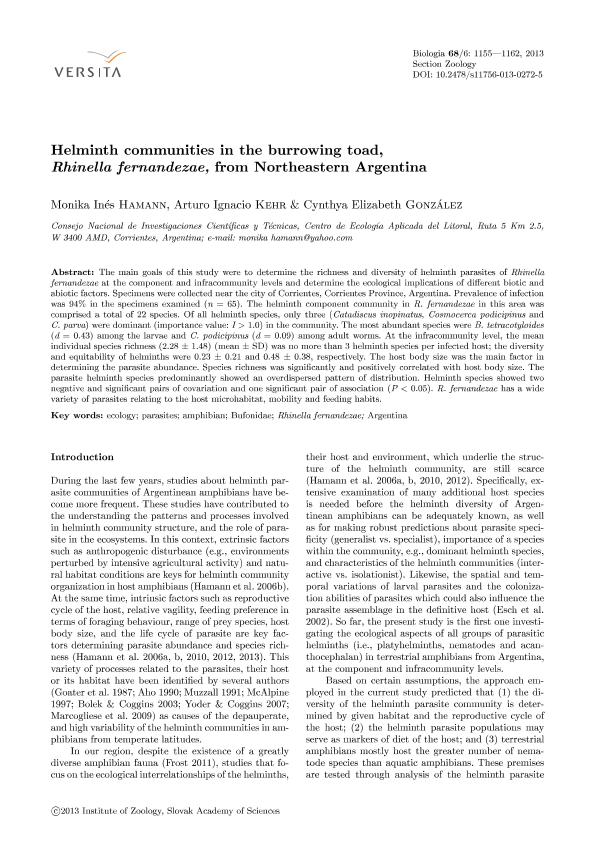Mostrar el registro sencillo del ítem
dc.contributor.author
Hamann, Monika Ines

dc.contributor.author
Kehr, Arturo Ignacio

dc.contributor.author
Gonzalez, Cynthya Elizabeth

dc.date.available
2015-10-08T15:41:53Z
dc.date.issued
2013-12
dc.identifier.citation
Hamann, Monika Ines; Kehr, Arturo Ignacio; Gonzalez, Cynthya Elizabeth; Helminth communities in the burrowing toad, Rhinella fernandezae, from Northeastern Argentina; Versita; Biologia; 68; 6; 12-2013; 1155-1162
dc.identifier.issn
0006-3088
dc.identifier.uri
http://hdl.handle.net/11336/2411
dc.description.abstract
The main goals of this study were to determine the richness and diversity of helminth parasites of Rhinella fernandezae at the component and infracommunity levels and determine the ecological implications of different biotic and abiotic factors. Specimens were collected near the city of Corrientes, Corrientes Province, Argentina. Prevalence of infection was 94% in the specimens examined (n = 65). The helminth component community in R. fernandezae in this area was comprised a total of 22 species. Of all helminth species, only three (Catadiscus inopinatus, Cosmocerca podicipinus and C. parva) were dominant (importance value: I > 1.0) in the community. The most abundant species were B. tetracotyloides (d = 0.43) among the larvae and C. podicipinus (d = 0.09) among adult worms. At the infracommunity level, the mean individual species richness (2.28 ± 1.48) (mean±SD) was no more than 3 helminth species per infected host; the diversity and equitability of helminths were 0.23 ± 0.21 and 0.48 ± 0.38, respectively. The host body size was the main factor in determining the parasite abundance. Species richness was significantly and positively correlated with host body size. The parasite helminth species predominantly showed an overdispersed pattern of distribution. Helminth species showed two negative and significant pairs of covariation and one significant pair of association (P 0.05). R. fernandezae has a wide variety of parasites relating to the host microhabitat, mobility and feeding habits.
dc.format
application/pdf
dc.language.iso
eng
dc.publisher
Versita

dc.rights
info:eu-repo/semantics/openAccess
dc.rights.uri
https://creativecommons.org/licenses/by-nc-nd/2.5/ar/
dc.subject
AMPHIBIAN
dc.subject
ARGENTINA
dc.subject
BUFONIDAE
dc.subject
ECOLOGY
dc.subject
PARASITES
dc.subject
RHINELLA FERNANDEZAE
dc.subject.classification
Zoología, Ornitología, Entomología, Etología

dc.subject.classification
Ciencias Biológicas

dc.subject.classification
CIENCIAS NATURALES Y EXACTAS

dc.title
Helminth communities in the burrowing toad, Rhinella fernandezae, from Northeastern Argentina
dc.type
info:eu-repo/semantics/article
dc.type
info:ar-repo/semantics/artículo
dc.type
info:eu-repo/semantics/publishedVersion
dc.date.updated
2016-03-30 10:35:44.97925-03
dc.journal.volume
68
dc.journal.number
6
dc.journal.pagination
1155-1162
dc.journal.pais
Polonia

dc.journal.ciudad
Varsovia
dc.description.fil
Fil: Hamann, Monika Ines. Consejo Nacional de Investigaciones Científicas y Técnicas. Centro Científico Tecnológico Nordeste. Centro de Ecologia Aplicada del Litoral (i); Argentina
dc.description.fil
Fil: Kehr, Arturo Ignacio. Consejo Nacional de Investigaciones Científicas y Técnicas. Centro Científico Tecnológico Nordeste. Centro de Ecologia Aplicada del Litoral (i); Argentina
dc.description.fil
Fil: Gonzalez, Cynthya Elizabeth. Consejo Nacional de Investigaciones Científicas y Técnicas. Centro Científico Tecnológico Nordeste. Centro de Ecologia Aplicada del Litoral (i); Argentina
dc.journal.title
Biologia

dc.relation.alternativeid
info:eu-repo/semantics/altIdentifier/url/http://www.degruyter.com/view/j/biolog.2013.68.issue-6/s11756-013-0272-5/s11756-013-0272-5.xml
dc.relation.alternativeid
info:eu-repo/semantics/altIdentifier/doi/http://dx.doi.org/10.2478/s11756-013-0272-5
Archivos asociados
